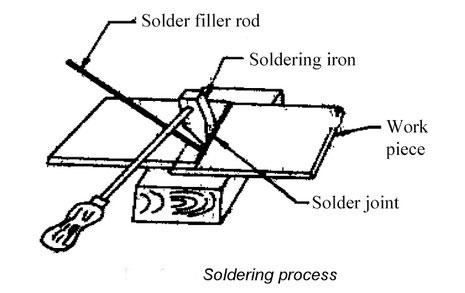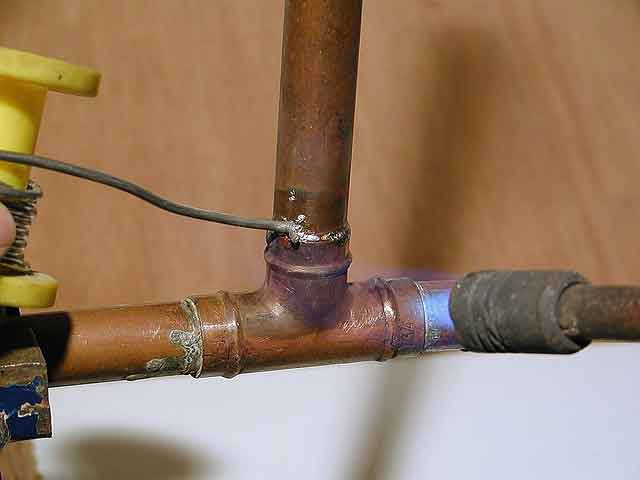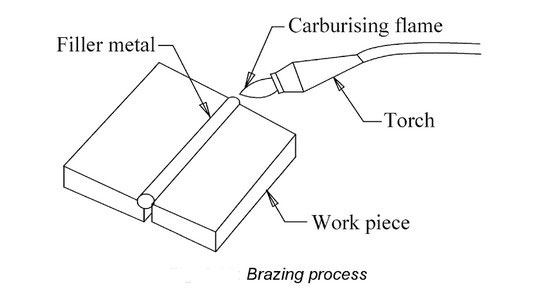In this article, you are going to learn in details that what is Soldering? And what is Brazing? Their process, advantages, and disadvantages.
You’ll also learn the difference between soldering and brazing (soldering vs. brazing).
Table of Contents
What is Soldering?
Soldering is the process of joining two metal pieces with the help of suitable filler material and at a temperature below 450°C.
Or it is a process of metal joining at a low temperature of about below 450° C.
The main advantages of soldering are that two dissimilar metals can also be joined. The filler metal used for soldering is called solder, and it is an alloy of lead and tin.

Different solder can be obtained by varying the proportions of lead and tin in the alloy.
The main characteristic of solder is that it can melt at low temperature because its melting point is low. Soldering operation does not involve melting the workpieces.
The solders available in the market are in the form of soft solder and hard solder. Soft solder is made up of lead and tin, and hard solder is made up of copper, tin, and silver.
These metals are mixed in different proportions to get a variety of solders.
A suitable flux is used in the soldering process to clean and remove the impurities produced due to oxidation. Usually, zinc chloride is used as a flux for the soldering process.
Soldering finds its applications in automotive and fabrication industries and is used in automotive radiators or tin cans.
It is also used in Electrical Connections in television and radio, joining thermally sensitive components, and sometimes used to join dissimilar metals.
Soldering Process / Procedure.
The soldering equipment is soldering iron, solder, or filler rod, power supply. The procedure of soldering is explained as below.

1. The workpieces must be cleaned before the soldering process. The presence of oil, grease, dist, wetness, rust, etc., is removed.
Sometimes suitable cleaning agents are used for cleaning the soldering surfaces. Presence of foreign materials on the surfaces to be soldered leads to weak joints lowers the strength of joint produced.
The commonly used cleaning agent is flux, such as borax or resin. This flux helps to remove all unwanted material from the surfaces of the workpiece and get strong bonding.
2. First, the soldering iron tip (made up of copper) is cleaned and heated. It is then applied with solder using resin. This will create a thin film of solder on the soldering iron tip and is called tinning.
3. Once the solder is taken in the soldering iron tip, the soldering iron tip is heated, and the solder will be melted. This melted solder then it flows over the joining area and fills the gap. Finally, the joint formed is allowed to cool slowly.
After complete soldering, the soldered surfaces must be cleaned. To clean the leftover flux, a suitable chemical is used, or it is cleaned by using cotton waste.
Advantages of soldering:
1. Dissimilar metals can be joined.
2. It is simple, low cost, flexible, economical, and user-friendly.
3. The life of the solder will be more.
4. Low amount of power is required to heat the soldering iron.
5. The soldering can be done at low temperature, and controlling is very easy.
6. Soldered joints can be dismantled.
Disadvantages of Soldering:
1. The soldering process can not join heavy sections. It is suitable for small parts only.
2. Solders are costlier, and soldering requires proper solder to get strong bonding.
3. Skilled labor is required for soldering.
What is Brazing?
Brazing is the process of joining two metal pieces with the help of non-ferrous filler metal at a comparatively higher temperature of about more than 450°C.
The brazing process is carried out below the melting point of the base metal and achieved by diffusion without fusion or melting of the base.
This process is most suitable for joining dissimilar metals and filler rod used must be made up of non-ferrous metal. The most commonly used filler metals are copper and copper alloys, silver and silver alloys, etc.
This filler metal fills the gap during the operation. The brazing process also needs a suitable flux to prevent the oxidation of the base metal, and commonly used fluxes are borax, fluorides, chlorides, and boric acid.
The brazing finds its applications in automobile radiators used for cooling, containers and other tanks, pipe fittings, heat exchangers, etc.

Credit: https://plumbwellplumbers.com.au/
Brazing Process / Procedure.
To carry out the brazing process, brazing torch, filler rod, flux, gaseous fuels (oxygen and acetylene) to get carburizing flame are required.
The procedure of brazing operation is explained below.
1. First, the surfaces to be joined are cleaned, and dist, oil, grease, oxide layers, and other foreign substances are removed.
2. Apply a suitable flux at where the brazing is to be carried out. This is used to avoid the base metal oxidation, and it helps to flow the filler material easily by capillary action.
3. Then, the filler material is placed at the place where brazing is to be carried out.
4. By using a carburizing flame, raise the temperature above the melting point of the filler material.
5. After raising the temperature of filler material, then molten metal is formed, and it flows into the gap by capillary action.
6. Allow the filler material and base metals to solidify.
7. Then, cool the base metals slowly to get a strong bonding.
8. The leftover fluxes are cleaned immediately after the brazing process because it is corrosive in nature.

Advantages of Brazing:
1. The brazing is an economical and straightforward process.
2. A brazing process can join dissimilar metals.
3. Low gauge or thin section plates are joined very easily, but such workpieces can not be joined by welding.
4. Metals with different thickness can be joined easily.
5. Joints produced with brazing process are better in appearance because stresses will not be induced, no metallurgical damages and distortion of the plate will take place.
6. Radiators, containers, and tanks, pipe fittings, heat exchangers can be brazed easily. But this cannot be done by welding.
7. Brazing produces leak-proof and pressures tight joints.
Disadvantages of Brazing:
1. Heavy sections can be joined by a brazing process. It is suitable for small and thin section plates only.
2. Skilled labor is required for brazing.
3. Brazing results in low strength joints compared to welding.
Brazing vs. Soldering; What’s the Difference.
Brazing.
1. Filler metal boiling point is above 450°C.
2. The filler metals may be of copper, aluminum, nickel, silver.
3. The flux used may be borax or boric acid.
4. The brazing produces stronger joints than soldering.
5. The brazing gives better accuracy, and joints may have a good aesthetic appearance.
6. Brazing is used in radiators, containers and other tanks, pipe fittings, heat exchangers.
Soldering.
1. Filler metal boiling point is below 450°C.
2. The filler metals are made up from of tin and lead.
3. The flux used is usually rosin, zinc chloride, aluminum chloride.
4. The soldering process produces less stronger joints compared to brazing.
5. The soldering does not give accuracy in the workpiece.
6. Soldering is used in electronic circuit board connections.